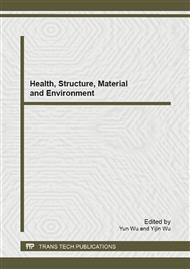[1]
Imai I., M. Yamaguchi, and M. Watanabe, in: Physiological Ecology of Harmful Algal Blooms, edited by D.M. Anderson, A.D. Cembella and G.M. Hallegraeff, Springer-Verlag, Berlin (1998).
DOI: 10.1017/s0025315400045033
Google Scholar
[2]
J.A. Marshall and G.M. Hallegraeff: Journal of Plankton Research Vol. 21 (1999), p.1809–1822.
Google Scholar
[3]
Y. Qi and C. Huang: Chinese Oceanologia et Limnologia Sinica Vol. 28 (1997), p.337–342.
Google Scholar
[4]
S.K. Mikhail: Chemistry and Ecology Vol. 23 (2007) , p.393–407.
Google Scholar
[5]
C.R. Tomas, in: Harmful Algae, edited by B. Reguera, J. Blanco, M.L. Fernandez, T. Wyatt, Xunta de Galicia and IOC of UNESCO, Spain (1998).
Google Scholar
[6]
R. Jugnu and V. Kripa: Indian Journal of Marine Sciences Vol. 38 (2009), p.77–88.
Google Scholar
[7]
Y. Nakamura, T. Umemori and M. Watanabe: Journal of Oceanography Vol. 45 (1989), p.116–128.
Google Scholar
[8]
S. Hiroishi, H. Okada, I. Imai and Y. Takashi: Harmful Algae Vol. 4 (2005), p.783–787.
Google Scholar
[9]
A.M. Waite and O. Lindahl: Marine Ecology Progress Series Vol. 326 (2006), p.77–83.
Google Scholar
[10]
C. Odebrecht and P.C. Abreu: 1995. Harmful Algal News Vol. 12-13 (1995), p.4.
Google Scholar
[11]
M.A. Tiffany, S.B. Barlow, V.E. Matey and S.H. Hurlbert: Hydrobiologia Vol. 466 (2001), p.187–194.
DOI: 10.1023/a:1014503920898
Google Scholar
[12]
J.S. Park, in: Recent approaches on red tide: Proceedings of the 1990 Korean–French Seminar on Red Tides held November 9-10, 1990, at National Fisheries Research and Development Agency , edited by J.S. Park and H.G. Kim, Republic of Korea, Korea (1991).
Google Scholar
[13]
E.G. Vrieling, R.P.T. Koeman, K. Nagasaki, L. Peperzak, W.W.C. Gieskes and M. Veenhuis: Netherlands Journal of Sea Research Vol. 33 (1995), p.183–191.
DOI: 10.1016/0077-7579(95)90005-5
Google Scholar
[14]
X. Jiao and H. Guo: Chinese Marine Environmental Science Vol. 15 (1996), p.41–45.
Google Scholar
[15]
T. Li, S. Liu, L. Huang, Z. Xu, K. Li, Q. Su, X. Song and J. Zhang: Chinese Journal of Tropical Oceanography Vol. 24 (2005), p.18–34.
Google Scholar
[16]
Guangdong Provincial Oceanic and Fishery Administration, P. R. China: Report on the Marine environmental quality in Guangdong P. R. China (2005).
Google Scholar
[17]
State Oceanic Administration People's Republic of China: Report on National marine environmental quality (2007).
Google Scholar
[18]
X. An, Z. Qi, X. Li and X. Zhang: Journal of Anhui Agriculture Science Vol. 36 (2008), p.13787–13788, 13861.
Google Scholar
[19]
Dalian City Oceanic and Fishery Administration, P. R. China: Report on the Marine environmental quality in Dalian P. R. China (2008).
Google Scholar
[20]
C. Yin, Q. Zhang, Y. Hu and H. Shi: Chinese Transaetions of Oeeanology and Limnology Vol. 1 (2006), p.114–119.
Google Scholar
[21]
Shandong Provincial Oceanic and Fishery Department, P. R. China: Report on the Marine environmental quality in Shandong P. R. China (2009).
Google Scholar
[22]
Y. Qi, Y. Hong, S. Lü, J. Chu, J. Zhang, C. Zhu, Y. Li, S. Liang and J. Li: Chinese Oceanologia et Limnologia Sinica Vol. 25 (1994), p.132–138.
Google Scholar
[23]
M. Yuan, C. Wang, Y. Yang: Marine Sciences Vol. 33 (2009), p.100–104.
Google Scholar
[24]
D. Liu, J.K. Keesing, Q. Xing and P. Shi: Marine Pollution Bulletin Vol. 58 (2009), p.888–895.
Google Scholar
[25]
F. Gao: The Study of Phytoplankton Community Structure and the Sexual Maturation of Pacific Oyster, Ocean University of China, Qingdao (2006).
Google Scholar
[26]
T.R. Parsons, Y. Maita and C.M. Lalli: A manual of chemical and biological methods for seawater analysis (Pergamon Press Oxford, 1984).
DOI: 10.1016/b978-0-08-030287-4.50046-3
Google Scholar
[27]
K. Grasshoff: Methods of seawater analysis (Verlag Chemie, Weinheim New York, 1976).
Google Scholar
[28]
H. Barnes: Apparatus and methods of oceanography, Part One: Chemical (George Allen and Unwin Ltd London, 1959).
Google Scholar
[29]
J.D.H. Strickland and T.R. Parsons: Vol. 167 (1972), p.311.
Google Scholar
[30]
S.C. Pai, C.C. Yang and J.P. Reliey: Analytria Chimica Acta, Vol. 232 (1990), p.345–349.
Google Scholar
[31]
B. Chen, Y. Cui, S. Ma, F. Xin and S. Zhou: Marine Fisheries Research Vol. 18 (1997), p.25–31.
Google Scholar
[32]
S. Kahn, O. Arakawa and Y. Onoue: Aquaculture Research Vol. 29 (1998), p.9–17.
Google Scholar
[33]
J. Chen, S. Ma, S. Zhou, Y. Cui, B. Chen and F. Xin: Marine Fisheries Research Vol. 18 (1997), p.61–67.
Google Scholar
[34]
M. Demura, M.H. Noël, F. Kasai, M.M. Watanabe, and M. Kawachi: Phycologia Vol. 48 (2009), p.518–535.
Google Scholar
[35]
Z. Wang, Y. Liang, S. Jiang, X. Chen and J. Li: Acta Scientiae Circumstantiae Vol. 30 (2010), p.1257–1264.
Google Scholar
[36]
M.R. McQuoid, A. Godhe and K. Nordberg: European Journal of Phycology Vol. 37 (2002), p.91–201.
Google Scholar
[37]
J.T. Hollibaugh, D.L.R. Seibert and W.H. Thomas: Journal of Phycology, Vol. 17 (1981), p.1–9.
Google Scholar
[38]
P.E. Hargraces and F.W. French: Survival strategies of the algae, edited by G.A. Fryxell, Cambridge University Press, Cambridge (1983).
Google Scholar
[39]
D.L. Garrison: Marine plankton life cycle strategies, edited by K.A. Steidinger and L.M. Waller, CRC Press, Boca Raton, Florida (1984).
Google Scholar
[40]
I. Imai, K. Itoh and M. Anraku: Bulletin of Plankton Society of Japan, Vol. 31 (1984), p.35–42.
Google Scholar
[41]
K. Ichimi, S. Meksumpun and S. Montani: Plankton Biology and Ecology, Vol. 50 (2003), p.22–24.
Google Scholar
[42]
Information on http: /www. sdxnw. gov. cn.
Google Scholar
[43]
Y. Nakamura and M.M. Waranabe: Journal of the Oceanographical Society of Japan, Vol. 39 (1983), p.110–114.
Google Scholar
[44]
X.G. Lü and F.L. Qiao: Geophysical Research Letters Vol. 35 (2008), doi: 10. 1029/2008GL036084.
Google Scholar
[45]
S. Zhang, Y. Liu, G. Zhang, L. Guan: Periodical of Ocean University of China Vol. 39 (2009), p.870–87.
Google Scholar
[46]
F. Qiao, D. Ma, M. Zhu, R. Li, J. Zang and H. Yu: Advances in Marine Science Vol. 26 (2008), p.409–410.
Google Scholar
[47]
C. Wang: Primary Studies on the Harmful Effects and Mechanisms of Ulva Prolifera Green Tide, Institute of Oceanology, Chinese Academy of Sciences, Qingdao (2010).
Google Scholar


